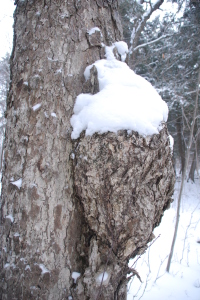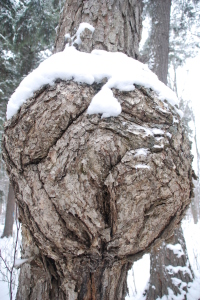Burls and Deer – Loring-Restoule
Deformities – Nature’s Beauty in Burls
by Back Roads Bill
A deformity is either actual or moral. It depends on your perception. Whether surveyed in an animate or inanimate object, there is beauty in deformity.
To most people, a tree burl wouldn’t look like anything special – in fact, these rounded growths found on tree trunks and branches are actually deformities. They often look like large round tumours growing on the trunk of the tree.
What is a Burl?
A burl is a tree outgrowth in which the grain has grown in a deformed manner. A burl results from a tree undergoing some form of stress. It may be caused by an injury, virus or fungus. While the bark covered exterior of a burl does not differ from the tree, the inside is often a beautifully patterned grain.
Hand carving and working a burl on a lathe are the most common ways of making a keepsake out of burl. Because of the rarity and difficulty of finding and working with burls most items made from a burl are expensive. The grain inside a burl is irregular and usually has very unique “swirls and eyes.” Burls are rare and this makes them highly prized by craftspeople and artists.
Burls as Works of Art
Michael Mathieu is a local artisan and is superlative at his craft. He understands burl wood is challenging to manipulate with hand tools because its grain is twisted and interlocked, causing it to chip and chatter unpredictably. This “wild grain” makes burl wood extremely dense and resistant to splitting, which makes it valued for bowls and artistic turnings. Michael does not use a lathe.
He started carving burls in 2006. “Searching for burls deep in the forests of Northern Ontario also feeds the need to explore and see the world around me.”
His pieces are best described as free-form burl wood carvings. “I use burl wood for the irregular and intricate patterns found within the burl. Each carved piece is unique from the next. Exact reproductions would be impossible to produce. The shape, colour, size and grain pattern are as diverse as nature itself. My goal with each piece is to create art that captures the soul of the tree. The warmth and beauty of each piece will draw you in to explore it further.”
“Using hand held tools to shape and form my pieces allows me to use nature as my guide. I can use the shape of the burl to define the piece rather than using a lathe to make the piece round. In almost all of my work you will see a natural, organic edge that is most inviting to touch and feel.”
Michael’s passion for wood and exploring the great outdoors has led him to carving burls into unique freeform bowls and vessels. These rare burls are very unique in colour, shape and size, and therefore his finished pieces are all one-of-a-kind. Michael says, “Finding a great burl is like finding a diamond in the rough.” Most of his burls are harvested locally from damaged trees, and unwanted wood that logging companies leave behind.” For Michael, true inspiration is found in the shape of the burl and the area from which it grew. In his work, you will see an organic, natural edge that reminds us of the wild spaces from which it came.
“For me, the first step in creating a burl carving is obtaining the right burl. This search for burls takes me to remote areas of Northern Ontario’s back roads. Often, I am able to find a tree that is dead, damaged, or left behind from logging operations. All of my materials are harvested in such a way as to have little impact on the environment. The burl is cut away with a chainsaw, and then lugged back to the truck. I use a sled or a pack board to move the wood. This is the most physically demanding part of the process.”
Once the burl is safely in the studio, he starts by cleaning off the bark and removing rotted areas. “I then use an electric chainsaw and a grinder to rough shape the piece. This is the time when a creative, spontaneous approach will help reveal the internal beauty of the wood. This is where the studio really gets messy. The roughed-out piece is then put away for several months to slowly dry. Waiting is the most difficult part.”
He uses a variety of wood files and chisels for fine details. Some burls can be over a hundred years old. “I always maximize the piece by using the natural shape of the wood. You only get one chance at it.” The artisan has another piece of advice, “once the wood is cut away, it can never be put back and patience is very important at this point.” When the final shape has been reached, the sanding begins. The final step is to finish the piece with several coats of Tung oil and buffed with wax. “The process from bush to polish can take several months to complete, and the journey is different and rewarding every time.”
See the Burls
If you want to see burls and combine it with a deer viewing/snowshoe experience, take a Sunday drive into Loring wintering deeryard  area, south of Lake Nipissing. You will snowshoe through mature hardwood and hemlock stands with plenty of regeneration needed as a food source and winter protection for the thousands of deer in the area.
area, south of Lake Nipissing. You will snowshoe through mature hardwood and hemlock stands with plenty of regeneration needed as a food source and winter protection for the thousands of deer in the area.
Take Highway 11 South and exit the Hemlock Rd., Trout Creek and Port Loring exit. Take 522b to 522; in Trout Creek turn west on to Highway 522; travel 39 km to Little River Rd and turn east (left). Set your odometer. Travelling slowly and you will see deer tracks on and crossing the road; you are almost guaranteed to see a deer.
Travel 3.9 km and you see the remains of the former interpretative trail signs east side (left); park alongside the road. (You can travel another 0.9 km and turnaround at the snowmobile OFSC C105d trail.) The former walking trailhead is at WGS 84 17 T E 597257 N 5085675 or N45° 55’ 03.9” W79° 44’ 45.0”. Follow the faded blue blazes eastwards. Within 100 m you will see the elevated viewing platform where at one time you could see many deer, through a supplementary feeding program where a grain mix was provided as a food source.
There is a preponderance of burls visible on the trail, a large one on a maple tree is located at N45° 55’ 07.4” W79° 44’ 31.7” or 17 T 597542 5085786; 10 m on the south side close to the wetland. You can follow the trail in a clockwise orientation, cross the Little River Road and travel NW while winding your way back at the former trailhead taking the trail on the west side of the road. You are never too far from the road; the loop is approximately 4 km. Follow the deer tracks they take the path of least resistance.
There is the 3rd century Greek saying, “Beauty is in the eye of the beholder.” As a subjective evaluation beauty in nature then is all around us. Every burl is different and unique because Mother Nature likes variety. You can see Michael’s work at www.northwoodcreations.ca or Art on Main downtown; 171 Main St. W. North Bay, ON www.artonmain.ca .
Click here for the KMZ and GDB files Download

